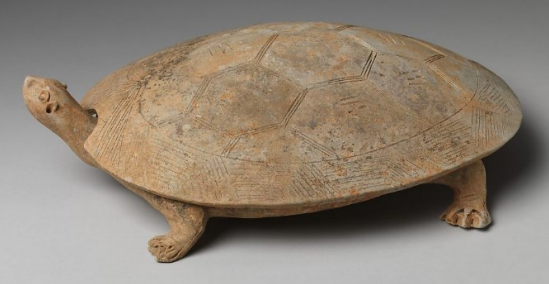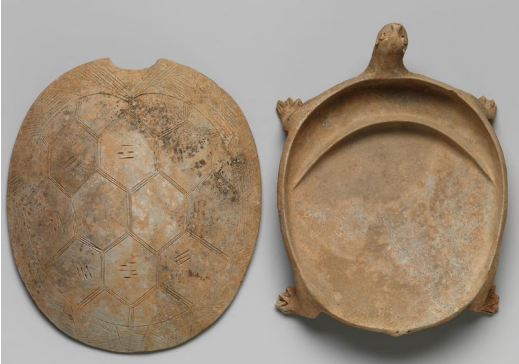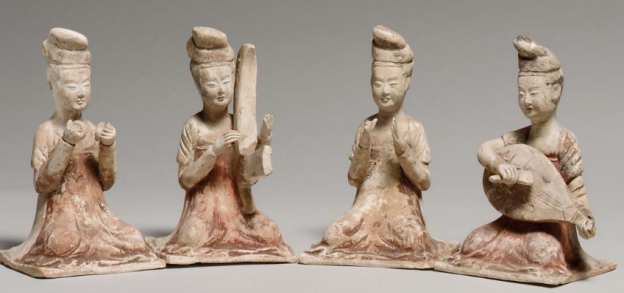8.2: Tang Social Structure
- Page ID
- 135134
The Super-Elite: Four Aristocracies Conjoined
A writer of Song times, when the Tang aristocracy had vanished, Shen Gua, likened Tang society to the caste system in India with its rigid inherited distinctions. At the top of Tang society stood the super-elite. They belonged to four separate aristocracies, each made up of many clans documented in various lists and genealogies that have been found among the archives at Dunhuang. First, the clans of the northeast (Hebei) claimed to represent the purest Chinese tradition of the Classics and Confucianism, with family lines reaching back to Han times. They married only among themselves -- unless a prospective mate was very wealthy indeed. They considered the Tang royal family of Li to be mere social upstarts. Taizong challenged that view in 632, only to find to his dismay that genealogical research supported it.
Second, the clans of the northwest included the Sui and Tang ruling houses and others who had served under the northern dynasties, had Turkic roots, and maintained central Asian customs and contacts. Northwesterners thought themselves superior because of their military and governing abilities, but they had also adopted classical learning and Confucian family practices. Third were the great clans of northern Shanxi, who also had central Asian contacts. Fourth were the wealthy Yangzi valley clans of the Southern Dynasties, also originally Han-era clans who had fled south. They were proud of the elegant culture they had built on the foundations of the classics, Confucianism, Daoism and Buddhism, but northerners looked down on them as southern barbarians. These four regional aristocracies retained their place as the super-elite of Tang society until the end of the period.


The super-elite clans had each developed in a certain place going back to Han or Wei-Jin times. Each was labelled not only with a surname, such as Cui, that would be shared by many others, but also with the name of their home base, such as Boling. They had a strong sense of family tradition and history, documented in genealogies that listed clan members who had had successful political careers. (Any branch of a clan that failed to produce officials for a couple of generations would be dropped from the clan and its records.) Kinfolk, matrilineal as well as patrilineal, were important in sponsoring the next generation for high-ranking posts, so they married only with their social equals. Kin networks were the most important resource of the super-elite.
Members of the elite commanded deference from those below them, and each knew how to defer to his own superiors in age, rank, or status. By law their punishments were lighter. They had sumptuary privileges – the right to wear certain clothes, drive certain carriages, and so on. After moving to the capital region, they kept up the connection with the home place – even clan members who lived and died in the capital were buried back home until late in Tang times. That meant that everyone would meet at the tombs on certain festivals. As time went on, the clans spent less and less time back home; they preferred to be in the capital. It used to be thought that disconnection from those home bases was what ultimately brought them down, but that was true only indirectly, as we shall see.
What did the great clans of Tang times not have, compared with other elites? First, their home estates were not like Zhou feudal domains. They had to pay taxes, and in the north they did not even own the land – the Tang central state did. In the south, estates were divided among sons, so they did not last long or expand. Clan members and their tenants were all subject to the Tang Code and bureaucratic government. Second, the did not have the kind of lineage organizations that formed in Song and especially Ming times, in which clans had shared, corporately-held land, and written rules that gave them institutional continuity. Third, unlike the aristocratic clans of Japan, they did not each have a deity. They did not even have ancestral temples for the whole clan, only meetings at the tombs.8
Scholars, Commoners, and Slaves
Below the super-elite, a hundred or so prominent clans in each locality, called shi zu or “scholar clans,” constituted the middle range of the aristocracy. They recognized one another as good families, and cultivated family solidarity through rituals centered on ancestral temples and graves, through formality of relations between the generations and the sexes, through an ethic of discipline and responsibility to the family, and through traditions of learning. They held office and served the Tang state in many capacities. Another set of families constituted the lower elite, powerful in their local areas.
Below them was the vast group of commoners, called “good people” (良民). Unlike in Qin and Han times, commoners held no rank, but were respectable. Below them were private retainers, who belonged to other households, but could legally marry commoners. Below them were base people, a category that included groups who hereditarily performed polluting tasks like music and acting, prostitution, and tending to the dead. Slaves were also base people.
Some slaves were purchased along the silk roads. For instance, after Tang conquered the kingdom of Gaochang in 640, Tang issued market contracts that validated the sale of slaves there. One excavated travel permit lists seven slaves with names like “Model Trustworthiness” and “Submit to Orders.” Among four travel parties of Tang officials, two-thirds of the laborers listed were slaves belonging to the officials.9 As in Han times commoners could slide down the social scale to become slaves, if a kinsman committed a serious crime, or to pay a debt; but unlike in Han times, there was no rising out of slavery again. In dramatic contrast to the Legalist principle that the state came first, a slave who informed on his master for any crime less than treason was liable to be judicially strangled. And unlike in Han times when a freed slave carried no taint, even manumission did not dissolve the obligation of a slave to be loyal to his former master. Slaves were supposed to marry only other slaves, because the distinction of rank was so important.



